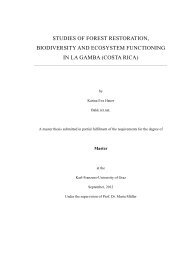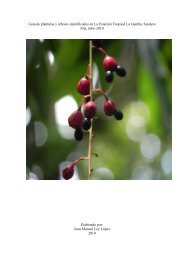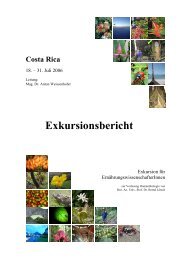Leaf colour patterns, vegetative and sexual reproduction of Episcia ...
Leaf colour patterns, vegetative and sexual reproduction of Episcia ...
Leaf colour patterns, vegetative and sexual reproduction of Episcia ...
Create successful ePaper yourself
Turn your PDF publications into a flip-book with our unique Google optimized e-Paper software.
Euglossini are a tribe within the family Apidae, which are also called orchid bees. The<br />
proboscises <strong>of</strong> orchid bees are up to 41 mm long (Roubik <strong>and</strong> Hanson 2004). Euglossine bees<br />
use the nectar <strong>of</strong> the flowers <strong>of</strong> Gesneriaceae as an important food resource (Endress 1994).<br />
Butterflies do not forage on flowers with a corolla depth that exceeds their tongue length<br />
(Corbet 2000). From that, it can be concluded that its proboscis has to be <strong>of</strong> at least equal length<br />
as the tube. Because there is a positive relationship between body length <strong>and</strong> proboscis length in<br />
the family <strong>of</strong> Lepidoptera (Kunte 2007), conclusions considering their size can be drawn. Thus<br />
smaller butterfly species can be excluded from the group <strong>of</strong> possible pollinators.<br />
Length <strong>of</strong> tube alone delivers no further indication to exclude one <strong>of</strong> the insects that are<br />
considered possible pollinators until now.<br />
The narrow entrance to the flower is supposed to prevent pollinators from penetrating too<br />
deep into the inside <strong>of</strong> the flower. Additionally, the insect is positioned correctly to be brought in<br />
contact with the pollen as well as being able to pollinate the style. During this process the pollen<br />
is supposedly placed on its head or proboscis. It is quite interesting that the tube broadens right<br />
after the narrow entrance significantly to almost double the size <strong>of</strong> the narrowest part before<br />
narrowing again in the rear section. Such an expanse can also be observed with other tubular<br />
flowers in the family <strong>of</strong> Gesneriaceae, e.g. Nauticalyx or Paradrymonia. The entrance <strong>of</strong> the flower<br />
is alike the narrowest part <strong>of</strong> the tube because both cross-section areas differ only rarely in size.<br />
Because <strong>of</strong> the narrowest part being located in the rear part <strong>of</strong> the flower it likely serves as<br />
guidance for the proboscis so that it can reach the nectar.<br />
The size <strong>of</strong> the floral display can matter in attraction <strong>of</strong> pollinators. Within most plant<br />
species, pollinators generally select in favour <strong>of</strong> large flowers (Pellmyr 2002). The limb diameter<br />
<strong>of</strong> averaged 42 mm forms a spacious l<strong>and</strong>ing area for insects. Thus the flower is almost as long as<br />
it is wide. The attracting effect <strong>of</strong> the big limb is quite considerable.<br />
If the sum <strong>of</strong> the length <strong>of</strong> style <strong>and</strong> height <strong>of</strong> ovary is compared to the length <strong>of</strong> stamina<br />
approximately equal values are reached. This indicates that the stigma indeed comes to a halt on<br />
roughly the same position that had held the anthers before. Thus the application <strong>of</strong> pollen from<br />
the body <strong>of</strong> the pollinator on the stigma is guaranteed.<br />
Bud Development<br />
Before referring to the process <strong>of</strong> anthesis more exactly, the bud development shall be taken<br />
into observation. The morphological changes in bud development <strong>and</strong> growth are described,<br />
rather than absolute changes in bud size or stem growth, because they are more indicative <strong>of</strong><br />
development than mere increase in size <strong>and</strong> length.<br />
56
















